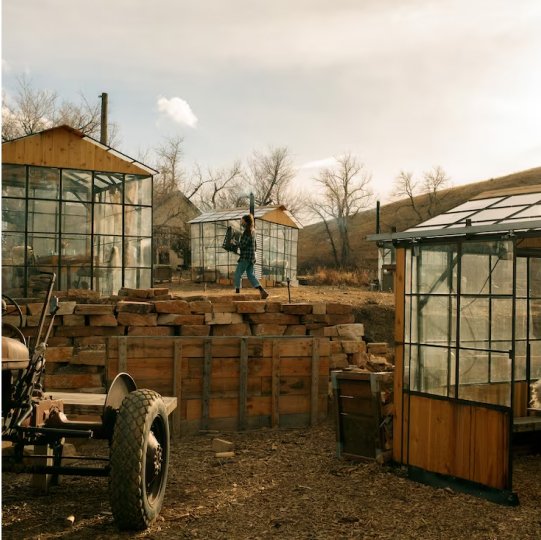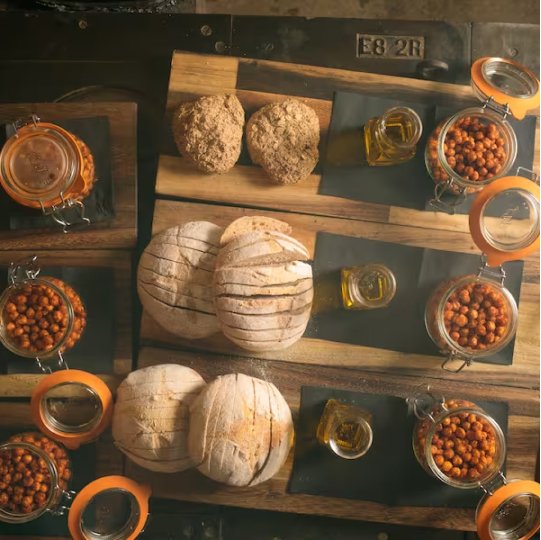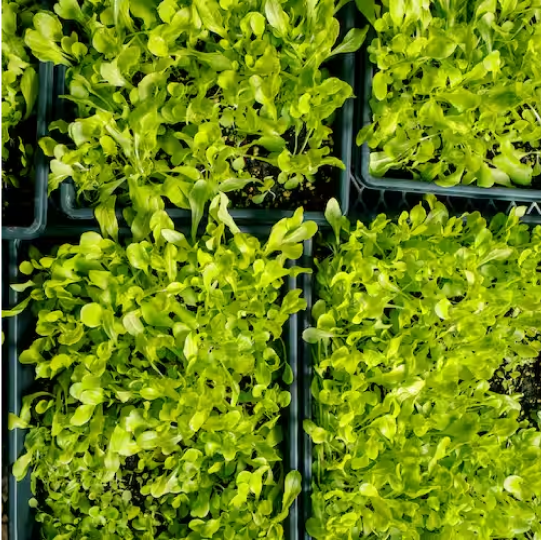Finding ways to grow during a year of loss
by Jennifer Oldham
Guests dine inside heated cabanas that chef Eric Skokan built on his farm in Longmont, Colo. (Photo: Matthew Staver for The Washington Post)
The article was originally published in The Washington Post ⸱ February 24, 2021
Colorado restaurateur Eric Skokan perseveres with a gutsy reinvention — that’s not yet finished
Longmont, Colo. — Bruised clouds loom over the charred foothills of the Rocky Mountains, and a frigid wind tears at the hand-lettered sign that hangs from a new wooden shelter barely a dozen yards off the road. A 17-year-old lies buried here. “You will not be forgotten,” the sign reads.
In a low-slung greenhouse just steps away, the boy’s father is back to work, coaxing chartreuse baby lettuce to life. Fresh mizuna and tatsoi will soon join sweet spinach, sprouting outdoors under gauzy sheets. The greens are among the few vegetables on Eric Skokan’s Black Cat Organic Farm while the frozen earth holds its breath.
“We’re at the nadir of the year in terms of production,” he says.
At 51, the trailblazing “chef farmer” is slowly emerging from a nadir all his own.
When the coronavirus pandemic shuttered his two Boulder restaurants in early spring 2020, Skokan reinvented his farm-to-table business to keep most employees on payroll. He offered takeout, opened a year-round farm stand and refurbished a vintage ice cream truck to deliver made-to-order meals. Neither of his restaurants had enough room for outdoor dining, so he turned to his 425-acre farm and erected umbrellas over wooden tables on a dahlia-and-strawberry-covered hillside.
Black Cat Organic Farm in Longmont covers 425 acres near the foothills of the Rocky Mountains. (Photos: Matthew Staver for The Washington Post)
When a summer thunderstorm sent the umbrellas careening over the fence into the buffalo paddock next door, Skokan hired workers to help construct eight cabanas out of decades-old tempered glass from former carnation greenhouses. His new strategy seemed to be succeeding. Every Monday morning, patrons would snap up a week’s worth of dinner reservations at the unique rural retreat.
Then, on July 24, as Skokan prepared a cabana for guests, a speeding dump truck lost control on the tight curve of Nelson Road that borders the property, swerved into the oncoming lane and hit a car. Two of his sons, Kelsey and Ian, were in the convertible.
Younger brother Kelsey, 17, was crushed in the driver’s seat. The truck pushed the car back 40 feet, veered off the road, careened down an embankment and plowed into the homestead’s century-old farmhouse.
Skokan and his wife, Jill, lived elsewhere for months with Ian, 22, and their other children, Morgan, 24, and Avery, 15. His son’s death almost broke him in a way the pandemic could not.
A shelter protects the grave of Skokan's son Kelsey, who died in a car crash. (Photo: Matthew Staver for The Washington Post)
“Death and grief open up a black hole, and you feel yourself falling into it.”
Skokan said in early February, pausing to take a deep breath. “My phone exploded with condolences — lots of hands reached out and pulled Jill and I out of that hole and helped create a space to heal.”
Their recovery is indeed a story of shared anguish. Yet the collective action that followed not only supported a grieving family but sustained a treasured part of the community. And it’s not finished.
“I’m just now able to function mentally in any significant capacity,” Skokan allowed.
In the aftermath of the crash over the summer, scores of neighbors, patrons and friends pitched in to harvest vegetables, bottle-feed lambs, move fence lines and even assist on the Skokans’ house reconstruction. The generosity stunned Megan Henderson, a writer and former farmer who created a GoFundMe page that quickly garnered more than $260,000.
“I was pretty much fielding email and phone calls for two weeks solid,” she said. “You can’t just hang a closed sign on the door of your farm.”
As the volunteers came to Skokan’s aid, his wife, who runs the business operation, urged him to take care of their employees.
“My goal became to make farm dinners stable so I could feel comfortable saying to staff, ‘We’ve got you,’ ” he said. “We can keep going until the vaccine kicks in.”
Left: Server Taylor DeVaughn prepares the farm's cabanas for guests. Right: Dinners at the farm never lack for homemade bread. (Photos by Matthew Staver for The Washington Post)
Skokan’s employees, in turn, also took care of him. He and his family were away when a wildfire bore down on the farm in October. The staff saved the day: Waiters, sommeliers and cooks dug fire lines as 150-foot flames consumed homes on the nearby hillsides. Smoke shut down the farm dinners. The blaze came within a mile of the property before being extinguished.
“We have a team that just says yes to anything,” said Izzy Robie, who graduated in May from the University of Colorado at Boulder with a psychology degree and relies on money from waiting tables at the farm to pay down student loans. “We all knew no matter what happened, we would get through this together.”
Robie, who worked at Skokan’s Bramble & Hare restaurant before the pandemic, learned new skills after her boss pivoted his business model in mid-March 2020, days before Gov. Jared Polis (D) announced restaurant closures to slow the spread of the virus. She helped to manage the farm stand, where customers lined up to purchase meat from Red Wattle pigs and Tunis sheep raised by the Skokans. Potatoes and turnips from the root cellar sold out, as did fettuccine and sourdough bread crafted from organic grains grown and milled on the farm.
At the Black Cat Farm Table Bistro — which is connected to the Bramble & Hare in downtown Boulder — employees filled to-go orders with specialties such as Mulefoot pork with polenta, braised greens and guajillo salsa. For the rest of the spring, they made daily deliveries with a 53-year-old ice cream truck they named Mabel. Her neighborhood routes kept expanding as new customers called in.
“Covid-19 has erased all habits and allowed smaller farms to have more face time with customers,” Skokan marveled at the time.
LEFT: Skokan plants onion seeds in his greenhouse in February. RIGHT: The farm grows greens year-round. (Photos by Matthew Staver for The Washington Post)
Mabel helped sell a year’s worth of grain — 5,000 pounds — in two months. Customers purchased 500 gallons of lettuce each week. After a broken wheel sidelined the truck, the Skokans bought Mabel No. 2 and No. 3. Given their popularity, as well as demand at the farm stand, Skokan planted more of the 250 heritage herbs, grains and vegetables for which he’s known.
A longtime chef, he forged his reputation as a pioneer of the farm-to-table movement when he married his lifelong passions of cooking and gardening in the mid-2000s. Today, he raises nearly all the ingredients in his dishes.
Just as the nine-year-old farm was about to welcome diners in June, Skokan and two employees fell ill with covid-19. Eight other staff quarantined. The Mabels were grounded.
“Keep in mind I’m a chef who drives a tractor,” he mused at the time. “I’m very much, in a lot of this, out of my element and learning as I go.” And despite his worries about the path forward, he reveled in the farm’s bounty: “I took a break and sat down in the rows with sugar snap peas and ate myself into a coma — they are like candy.”
Seven months later and a dozen miles south in Boulder, Skokan stands inside the Black Cat restaurant, where chairs and tables are still stacked against the walls. His business continues to be a recovery in process. Behind a counter, near a vacant stovetop, sous chef Heraclio Silva fills containers with homemade guacamole for sale at the farm stand. The Bramble & Hare remains dark, quiet and empty. The chef hopes to reopen in early April. Total revenue is down by half, but a $300,000 federal government loan and all of the Skokans’ savings allowed them to keep most operations running and almost everyone employed.
“I find it mentally challenging to be here — the ghosts of old memories are making their way through this place,” Skokan says. “At the farm, things are about growth and rebirth.”
After dinner each evening, he and Silva write the next day’s menu based on what’s available from the farm. The following morning, workers harvest produce and bring it to the restaurant, where prep is done. The ingredients then are driven back to the farm and combined in a cozy kitchen in a barn built around 1883.
Gone are tasting plates with swirled sauces, in are hearty stews served from cast-iron Dutch ovens. The transparent cabanas are infused with candlelight and heated with vintage wood stoves. Woolly white sheepskins line the chairs. Three additional tables are in glassed-in rooms in the barn. Patrons call a visit “an entirely new experience.”
Jackson Helwig lights a wood-burning stove inside one of the farm's dinner cabanas. (Matthew Staver for The Washington Post)
There’s an antique feel to it,” says Todd Walsh, who has dined in a cabana with his wife. “You have chickens walking by and ducks visiting you while you’re having this exquisite food.”
A Wednesday evening finds Skokan in the barn chopping magenta beets to roast and toss with arugula and a lentil vinaigrette. He slices beef shank purchased from a nearby rancher for a ragu of tomatoes, onions and carrots, to be served over goat-cheese-filled pasta.
The chef farmer, who over the years has nurtured his fields through floods, locusts and early frosts that annihilated thousands of dollars worth of crops, says he believes the repeated pivots to survive the pandemic have birthed a unique business model with staying power.
“My dream was to have this be a licensed kitchen, and I could commute to work past Jack the guard goose and the flower garden,” he says with a chuckle. “It’s a scramble to keep staff employed and not go bankrupt. But our customers, instead of comparing us to an a la carte restaurant in town, are taking this as a style all its own.”
The illuminated greenhouse seems to glow as night falls on the farm, the silhouette of Colorado foothills visible in the distance.
The illuminated greenhouse seems to glow as night falls on the farm, the silhouette of Colorado foothills visible in the distance. (Matthew Staver for The Washington Post)








